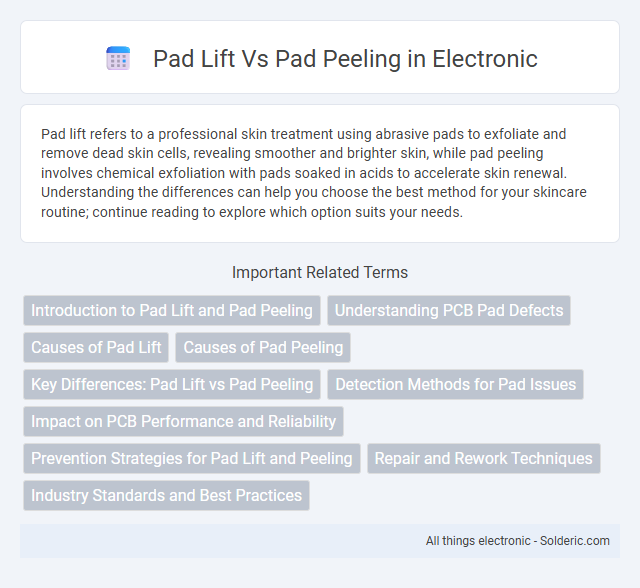Pad lift refers to a professional skin treatment using abrasive pads to exfoliate and remove dead skin cells, revealing smoother and brighter skin, while pad peeling involves chemical exfoliation with pads soaked in acids to accelerate skin renewal. Understanding the differences can help you choose the best method for your skincare routine; continue reading to explore which option suits your needs.
Comparison Table
| Aspect | Pad Lift | Pad Peeling |
|---|---|---|
| Definition | Separation of pad layers due to adhesive failure, causing lifting. | Complete removal or shedding of the pad surface layer. |
| Causes | Poor adhesion, moisture, or material incompatibility. | Excessive wear, chemical damage, or mechanical stress. |
| Appearance | Raised edges and partial separation from substrate. | Flaking, chipping, or peeling off in large pieces. |
| Impact | Reduced bonding strength and potential contamination. | Loss of protective surface, exposing underlying material. |
| Common Industries | Electronics, construction, automotive (adhesive pads). | Coatings, packaging, wearable products. |
Introduction to Pad Lift and Pad Peeling
Pad lift involves using a specialized adhesive pad to gently raise and reshape sagging skin, enhancing facial contours with minimal downtime. Pad peeling is a skincare technique that employs exfoliating pads containing acids or enzymes to remove dead skin cells, promoting smoother texture and brighter complexion. Understanding how these treatments target different skin concerns can help you choose the best option for your skincare goals.
Understanding PCB Pad Defects
Pad lift and pad peeling are common PCB pad defects caused by inadequate adhesion between the pad and substrate, leading to electrical connectivity issues. Pad lift occurs when the pad detaches from the PCB surface, often due to excessive heat or mechanical stress during soldering, while pad peeling involves the lifting and separation of the copper pad's outer layer. Understanding these defects helps you improve manufacturing processes and ensure reliable solder joints in your PCB assemblies.
Causes of Pad Lift
Pad lift occurs primarily due to adhesion failure between the brake pad and the backing plate, often caused by contamination, excessive heat, or poor manufacturing. Excessive heat generated during aggressive braking weakens the bond, leading to partial or complete detachment of the friction material. Contaminants such as oil, grease, or road debris can also compromise adhesion, resulting in pad lift and reduced braking performance.
Causes of Pad Peeling
Pad peeling is primarily caused by improper application techniques, such as excessive pressure during installation or uneven adhesive distribution, leading to poor pad adhesion. Environmental factors like moisture, temperature fluctuations, and chemical exposure can weaken the bond between the pad and the surface, accelerating peeling. You can prevent pad peeling by ensuring correct installation procedures and maintaining optimal conditions for pad use.
Key Differences: Pad Lift vs Pad Peeling
Pad lift involves raising the nail enhancement from the natural nail due to poor adhesion or moisture infiltration, often creating a gap where debris can accumulate. Pad peeling refers to the actual lifting and subsequent peeling away of the nail enhancement pad, which occurs when the bond weakens extensively, commonly caused by improper application or damage. Key differences lie in pad lift being the initial separation phase, while pad peeling represents the complete detachment of the nail product.
Detection Methods for Pad Issues
Detection methods for pad lift primarily involve visual inspection using magnification tools or high-resolution cameras to identify gaps between the pad and substrate. Acoustic microscopy and X-ray imaging provide detailed internal views, revealing delamination or voids without damaging the pad. In contrast, pad peeling issues are often detected through mechanical testing and microscopic examination to assess adhesion strength and surface contamination leading to lift-off.
Impact on PCB Performance and Reliability
Pad lift compromises PCB performance by disrupting electrical connectivity and increasing resistance, leading to intermittent failures and reduced signal integrity. Pad peeling exposes copper traces to environmental contaminants, accelerating corrosion and weakening mechanical bonds, which undermines long-term reliability. You should evaluate PCB manufacturing and repair processes carefully to minimize pad damage and ensure consistent performance over the product's lifecycle.
Prevention Strategies for Pad Lift and Peeling
Prevention strategies for pad lift and peeling emphasize proper surface preparation, including thorough cleaning and drying to ensure strong adhesion. Utilizing high-quality adhesives and applying even pressure during installation reduce the risk of edge lifting and peeling over time. Controlling environmental factors such as temperature and humidity during application further enhances pad durability, preventing premature failure.
Repair and Rework Techniques
Pad lift and pad peeling are critical repair and rework techniques used in printed circuit board (PCB) manufacturing to fix damaged copper pads. Pad lift involves carefully removing and replacing the lifted pad to restore electrical connectivity, while pad peeling focuses on removing delaminated or peeled pads without damaging the underlying substrate. Your choice between these methods depends on the extent of damage, with pad lift suitable for minor lift issues and pad peeling employed when pads need complete removal for effective rework.
Industry Standards and Best Practices
Pad lift and pad peeling are industry-standard surface preparation issues recognized under ASTM and SSPC guidelines. Best practices involve adhering to specified anchor profile depths and proper surface cleanliness to ensure coating adhesion, with pad lift typically indicating inadequate lifting of the pad surface causing poor adhesion, while pad peeling relates to surface film detachment post-application. Inspectors use profile gauges and adhesion tests like pull-off tests to validate compliance with SSPC-SP standards and ensure long-term coating performance.
Pad lift vs pad peeling Infographic

 solderic.com
solderic.com